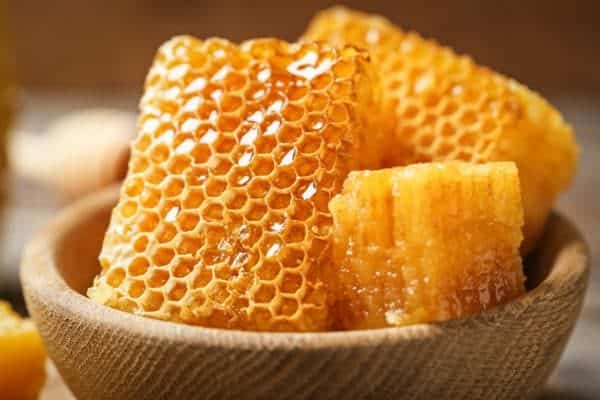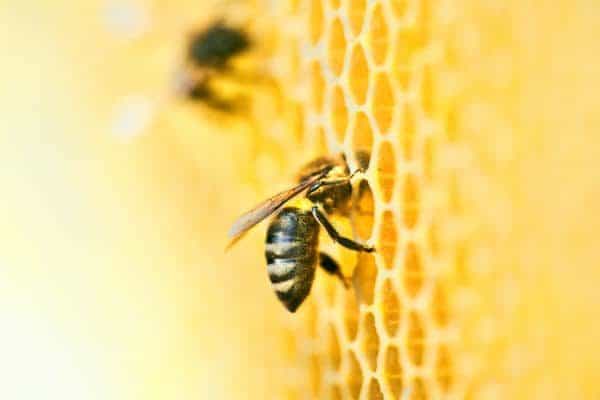People have been eating honey from time immemorial. In fact, it is one of the earliest sweeteners used by humans and one of the best ways to enjoy the fruit of the bee’s labor.

But, what about honeycomb? Is it edible? What can you do with it?
Yes, you can eat the entire honeycomb as well as the honey and waxy cells. It’s perfectly safe and one of nature’s finest delicacies. Human beings have enjoyed the benefits of honeycomb for many years. Even though the wax is tasteless, it stores the purest honey, which gives it a fantastic taste.
Honeycomb may be intimidating to some people due to its waxy structure, but it contains the best form of honey.
Read on to discover the health benefits of honeycomb, how you can enjoy it, how to store it, and much more.
What Is Honeycomb?
Honeycomb is a natural product made by honeybees. It comprises hexagonal cells set up from beeswax, which is secreted from special glands on the honey bees’ abdomen. It is a solid form of liquid honey.
It’s basically the bee’s pantry as they use it to store honey, royal jelly, propolis, pollen, and as a house for the larvae and eggs.
The honeycomb structure also adds protection to a beehive and acts as a medium of communication. It transmits the scent of queen pheromones; the bees can determine the health and productivity of the queen through the comb cells.
The process by which bees make wax is really fascinating. So much so we have dedicated a whole article to this topic. For a detailed explanation check out this article, How Do Bees Make Wax? The Incredible Process Revealed.
How Do Honey Bees Produce Wax To Make Combs?
A worker bee mixes a wax scale with saliva by chewing with her mandibles, which makes it pliable and suitable for building the cells. She manipulates the wax with legs, antennae, and mandible during construction. The wax temperature is about 37 degrees centigrade during this process.
A bee consumes approximately 3.8kg of honey to secrete about 454g of wax. That’s why it is advisable to return the combs to the hive once you harvest the honey.
Structure Of The Honeycomb
The cells in a honeycomb are amassed together in a hexagonal (six-sided) pattern. Why do honey bees prefer a hexagon rather than a square or circle? Well, that’s because our bumbling friends are incredibly intelligent and quite the architects as they have discovered a way of building their home fabulously well.
A hexagon provides more area or volume due to its longer perimeter than the other shapes. It also gives the utmost strength to the comb and leaves no gaps between the cells.

A hexagon shape also requires fewer building materials (wax) than other structures.
There is an exception of the hexagonal shape in a honeycomb; this being the queen cell. A cell designed to raise a queen is usually long and peanut-shaped. Although the cells for raising drones and workers are hexagonal, the cells for raising drones are larger.
Between the layers of the honeycombs, the bees leave a space of about 3/8th of an inch for their movement. The comb cells are slightly tilted upwards to prevent spillage of the contents.
Harvesting honey does not mean the destruction of the honeycombs. A centrifugal machine spins the liquid honey out, leaving the combs intact such that the bees can fill them again.
Color Of The Honeycomb
A newly made honeycomb is white in color, but it turns yellowish over time. The brood cells are dark brown since they are constantly in use as the workers feed the brood.
The dark color is also due to cocoon and larvae skin that gets stuck in the cells. Honey cells are capped and sealed once they are ready for storage.
Ways To Consume Honeycomb
Honeycomb is a pure food that can be mixed with other ingredients in many foods and drinks. It can also be crushed and sprinkled on other foods. Like honey, the taste of a honeycomb depends on the type of flower used for nectar and the environment.
Here are some diverse ways to enjoy your honeycomb:
Eat it Raw
Some people love eating crude honeycombs full of honey as it is delicious and packed with nutrients.
The next best honey to eat is raw and unfiltered honey. If you are not sure exactly what that means check out this article we have written, What Is Raw Unfiltered Honey?
Sprinkle On Other Foods
Those who want to add pizzazz to the honeycomb experience can crush honeycombs and spread it on other foods such as cheese, chocolate. It can level up any appetizer, or charcuterie board.
As A Sweetener
It can be used as a sweetener for coffee and coffee. It can also be added to smoothies, homemade desserts, yogurts, and chocolates. The combs also give a great aroma.
Used In Baking
Honeycombs can be mixed with the baking concoction while making scones and other pastries.
A Topping For salads
You can cut honeycomb into bite-sized pieces and drizzle it on your salad for an incredible sweet crunch and a visual appeal.
Spread On Bread
Comb honey, which consists of unextracted honey on the combs can be used as spreads on muffins, bread, and pastries. Due to its unique texture, it spreads out into a thick layer. Honeycomb in this nature preserves most of its flavor and nutrients.
Do You Swallow The Beeswax That Makes The Honeycomb?
Yes and no. You can chew it and spit out the wax or swallow it. It depends on you. You should however eat with caution; too much wax hardens and causes intestinal blockages. It can lead to constipation, abdominal swelling, and pain.
Health Benefits Of Honeycomb
Honeycombs comprise raw, unfiltered, and unprocessed honey so there are numerous compounds present to enhance your wellness.
Rich In Some Nutrients
Honeycomb is rich in antioxidants and carbohydrates. Its main component is raw honey, which is 95-99% water and sugar.
Since it is unprocessed, the raw honey contains enzymes like glucose oxidase, which gives honey its antibacterial properties. The enzyme is denatured by heating and filtering during processing.
Antioxidants promote health by reducing inflammation. The predominant type of antioxidant is polyphenols, which may help to reduce the risk of heart diseases, diabetes, and also certain types of cancer.
Honeycombs also contain proteins, vitamins, and minerals such as potassium and magnesium. Pollen in honeycombs is a natural antibiotic.
Promotes Heart Health
The beeswax contains long-chain fatty acids and alcohols that may help to reduce cholesterol levels, which is a contributing factor to heart disease. A study shows that beeswax may lower bad cholesterol by up to 29%.
Protect Against Infections
Honeycombs increase the body’s ability to fight some bacteria and fungi. It also has some antimicrobial properties, which may protect your gut against parasites.
It helps the body to retain probiotics, lowers levels of acidity in the gut, and fights ingestion. Coats the esophagus and stomach lining hence reducing bloating and heartburn.
Help To Treat Cough Or Sore Throat
Honey suppresses coughs. The wax esters from propolis and beeswax help to lower bronchial inflammation. The Antibacterial properties of honeycomb help to clear airway passages, which help to treat colds.
An Ideal Sugar Alternative For Diabetic People
A honeycomb is an excellent option for sugar for people suffering from diabetes. Since honey is sweeter than ordinary sugar, you use a small amount. Since it also raises blood sugars, it should also be used with caution.
Promotes Liver Function
Eating honeycombs can promote liver health by regulating blood sugar. The antioxidants neutralize toxins hence preventing their damage. Wax esters help to decrease insulin resistance.
Alleviates Allergy
Chewing honeycombs in an allergy season alleviates running nose, watery eyes, and sneezing. You can start chewing honeycombs earlier before an allergy season sets in to prevent allergy problems from manifesting.
Treating Periodontitis
Honeycombs help to treat gum disease. Its inflammatory and antioxidative nature help to fight the erosion of periodontal tissues.
Skin Care
Raw honey from combs is a popular skin moisturizer, a body scrub, or a mask. Beeswax is rich in vitamin A which acts as an emollient. It helps to soothe and hydrate the skin.
Boost energy Levels In The Body
Natural sugars, vitamins, and minerals in the honeycomb give a perfect boost of energy to your body.
Promotes Better Sleep
Eating honeycombs improves the quality of sleep since the proper balance of sugars for the liver helps to secrete hormones needed for a good night of zzzs.
Heal Wounds
Due to its antibacterial and antifungal properties, raw honey from honeycombs can be used to treat athlete foot, cuts, burns, and yeast infections.
Can You Freeze Honeycomb?
Honeycombs do not expire unless it is stored inappropriately or exposed to moisture. If stored at room temperature in an airtight container, it can have an incredibly long shelf life.
However, when stored in a jar of honey, it can speed up the crystallization of honey.
You can freeze the honeycomb if you’re not intending to use it for years. It is an acceptable way of storage.
You can also freeze it to protect it from wax months, also known as bee months. They inhabit and reproduce in the combs and can ruin them quickly. Freezing destroys all the stages of bee moth.
An adult moth lays eggs on the surface of the honeycomb. On hatching, the larvae burrow through the combs as it feeds on the empty cocoons and pollen.
Although you can freeze honeycomb, it is not advisable to refrigerate it. It becomes sticky and fragile.
If you need more information on whether beeswax can go bad then check out the article we have written where we cover this in more detail. It’s called, Can Beeswax Go Bad?
The Wrap Up
Honey from honeycombs is the purest form and has a wealth of benefits to our bodies. However, raw honey has a risk of C. botulinum, so there is a potential for contamination.
It is advisable to buy combs from a reputable source. You should also consume honeycombs in moderation. Eating too much can also cause digestion problems.
If allergic to bees or pollen, it is wise to avoid the honeycombs. The fact that it is also high in sugar, should be taken with caution.
As with honey, children under one year of age should not eat honeycomb.
